
(Click title to go directly to the review)
Advance Review: HELLBREAK #1
THE MULTIVERSITY GUIDEBOOK #1
Indie Jones presents HIGH CRIMES #9
Comic Book Movie Review: JUSTICE LEAGUE: THRONE OF ATLANTIS (2015)
KING: THE PHANTOM/FLASH GORDON #1
Indie Jones presents BIG HITTERS #1
THE DYING AND THE DEAD #1
Advance Review: THE DRESDEN FILES: DOWN TOWN #1
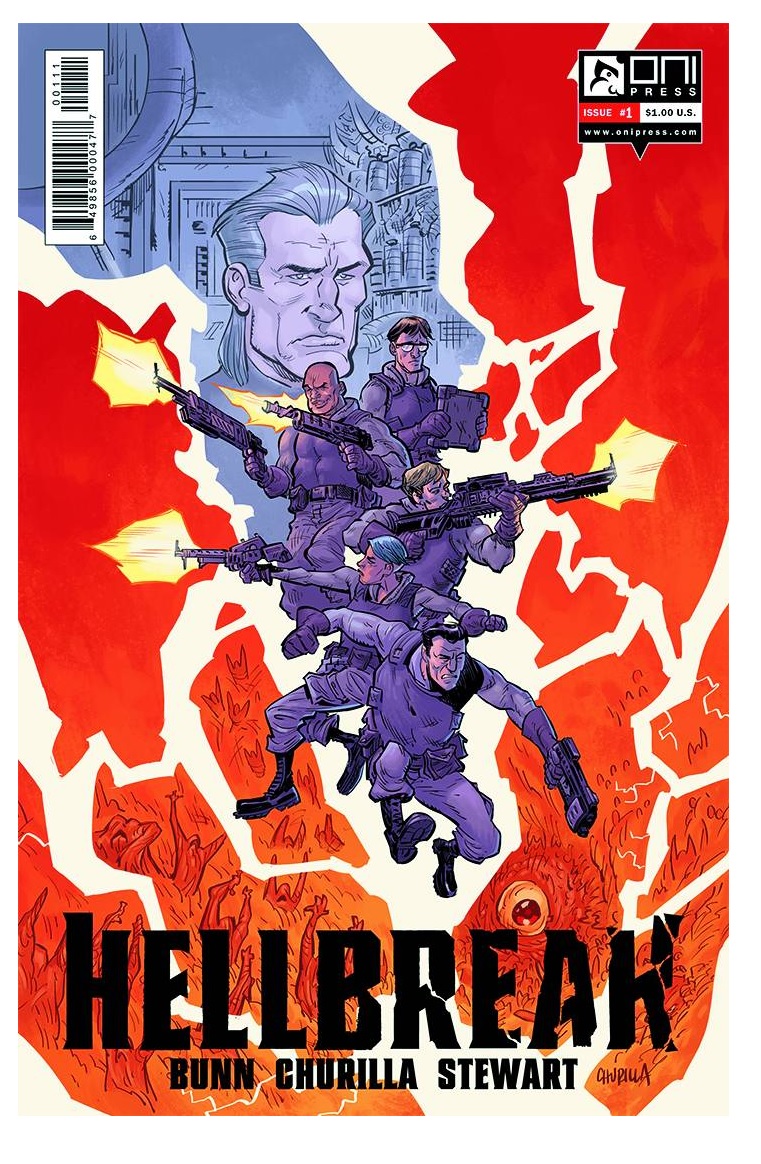
 In stores today!
In stores today!HELLBREAK #1
Writer: Cullen BunnArtist: Brian Churilla
Publisher: Oni Press
Reviewer: Lyzard
It may seem like a simple bit of wordplay, but one reference was enough for HELLBREAK to win me over. The comic opens with the famous Greek myth of Orpheus and Eurydice. Twitter version: Orpheus convinces Hades via song to release his love, on the condition Orph doesn't look back as he leads her out of the Underworld. He does.
The tale holds great pertinence to the actual storyline of HELLBREAK, but what I love is that the man orating the story is the senior project coordinator for the Kerberos Initiative. For those that wasted their foreign language requirements studying the Classics, the three-headed dog we know as Cerberus would phonetically, if going by the proper Greek pronunciation, start with a K. A toss-away reference for some, I frankly found the reverence and understanding a good omen for what was to follow.
The Kerberos Initiative performs exorcisms of a different sort. Though a priest and cross are involved, the real work is done by a team sent directly to the Underworld to free the cursed’s soul.
Unlike other journeys to hell, this one ain’t got no fire or brimstone. Each corner of the Underworld has its own personality. For this first issue we have an “Eyes Wide Shut” morbid masquerade ball going on. While the masks are creepy, what lies underneath is far worse. This is where HELLBREAK truly shines. The concept of various forms of the Underworld gives artist Brian Churilla such freedom of expression. His demonic creatures this time are a mix between French aristocracy and the “Last of Us” “zombies,” but the quick glimpses we get outside of the demon party reveal that there is so much more Churilla can pull on the next time the Kerberos Initiative has to perform an extraction.
It is hard at this point to judge whether or not the characters on the team are ones I can get behind. HELLBREAK #1 felt more like a teaser, a cold opener to a much bigger story. Yes, it is just an introductory issue, but the set-up still felt short. Not rushed necessarily, but it left me wanting more. Hopefully, having to wait months (as this first book isn’t even scheduled to be released until March) until the next issue will not result in my expectations growing too high.
If writer Cullen Bunn is able to build out these characters to be more than archetypes, then I do hope Oni Press intends to give HELLBREAK a long run. The concept is rife for more storylines--deeper exploration of a universe that could provide numerous spin-offs sans the already established characters.
Lyzard is Lyz Reblin, a graduate student at the University of Texas pursuing a master's degree in Media Studies...which is just a fancy way of saying she plays a lot video games, watches far too many horror films, and then tries to pass it all off as "research."
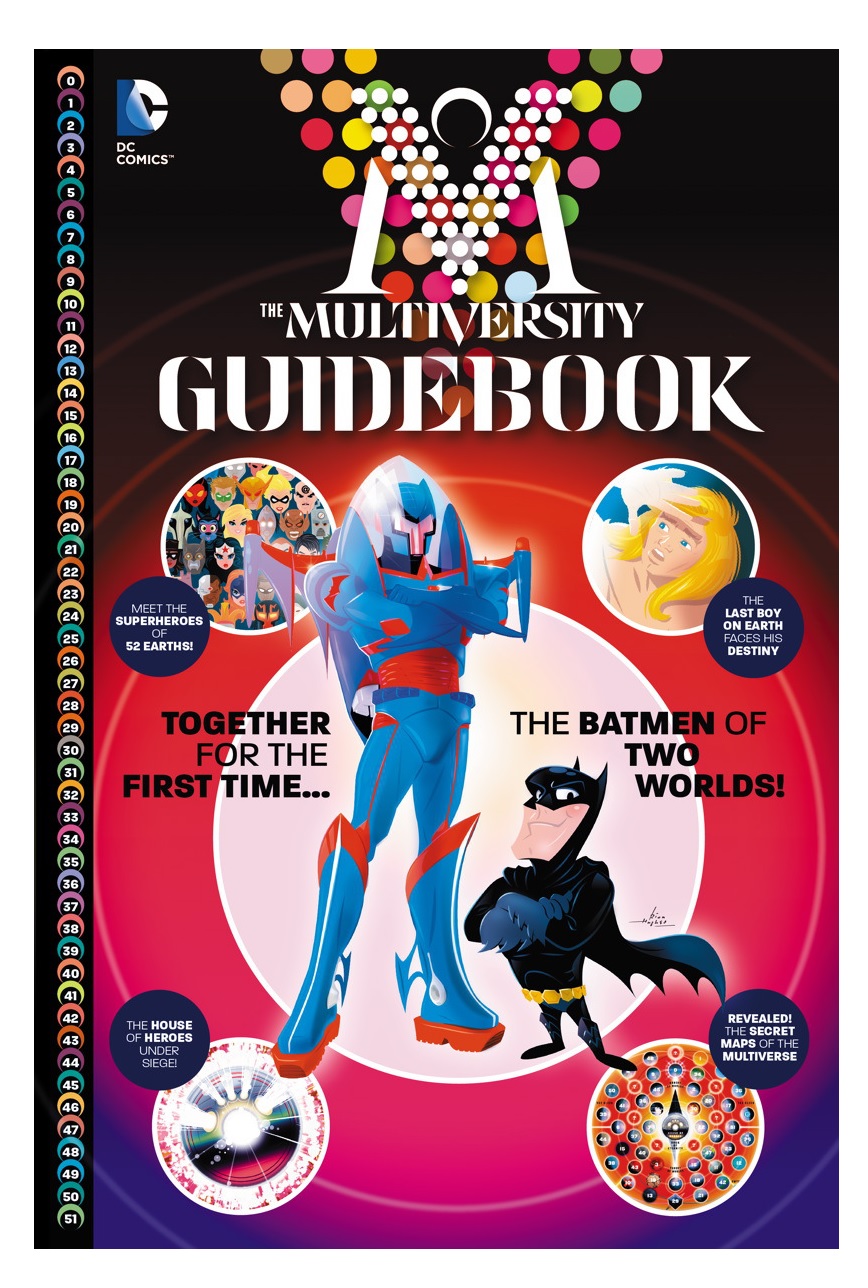
THE MULTIVERSITY GUIDEBOOK #1
Writer: Grant MorrisonArt: Various
Publisher: DC Comics
Reviewer: Masked Man
With three more issues of THE MULTIVERSITY to go before we hit CONVERGENCE (will it be something meaningful or just another RETRO-ACTIVE event?), DC and Grant Morrison drop THE MULTIVERSITY GUIDEBOOK on us, and it's just jam-packed with info. But before we go over all the crazy info, let's talk about the story in this 'Guidebook' as well.
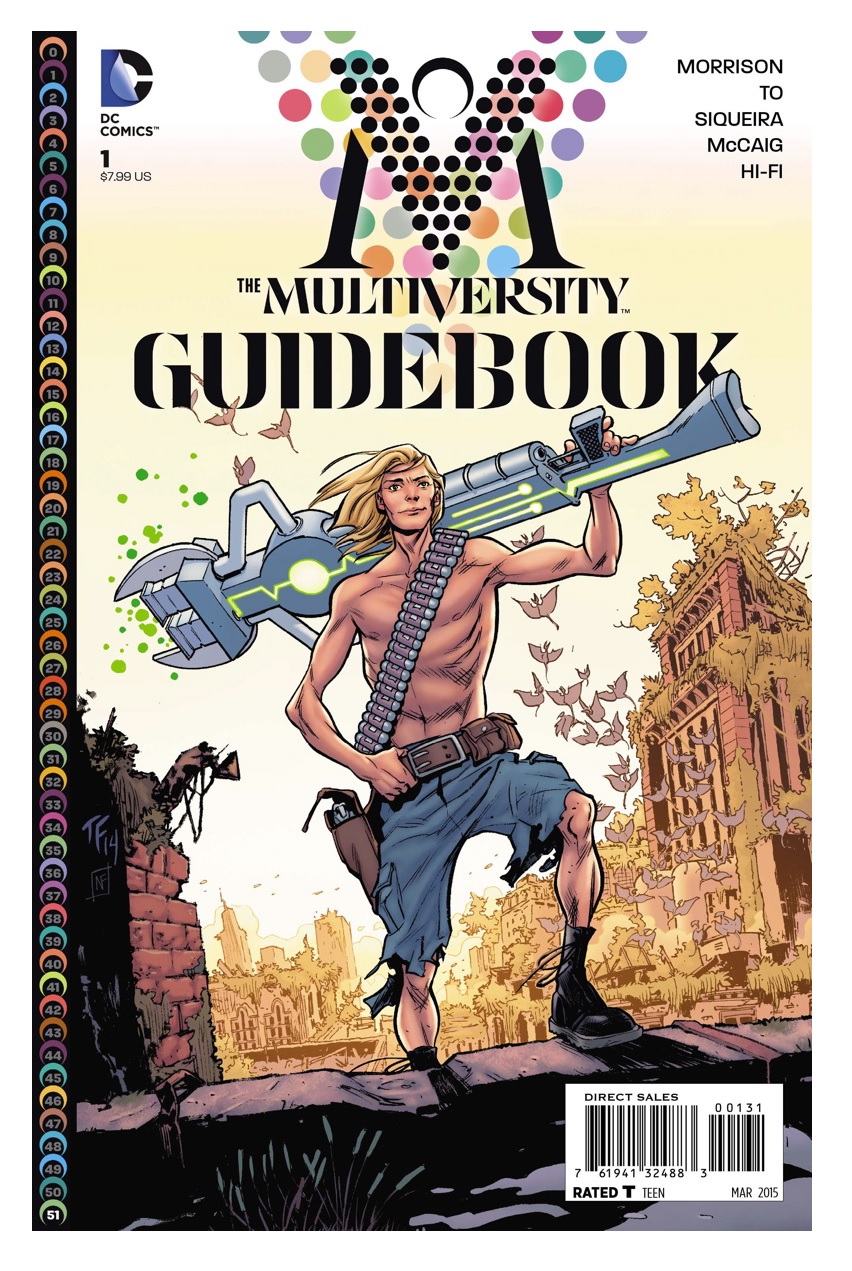 Morrison has two tales here, or rather two story fragments here, both well illustrated by Marcus To and Paulo Siquera, Paulo Siquera's Earth-51/Kamandi pages were most impressive. The Kamandi story also includes the most articulate pictogram in the history of creation. The nicest thing about these fragments is that Morrison is drawing the different narratives of THE MULTIVERSITY together more instead of simply stating over and over and over and over that one of Earth's comic books is another Earth's history. Anyway, Captain Marvel (from THUNDERWORLD) is in hot pursuit of the Legion of Sivanas, who are using 'this' very Guidebook to travel the Multiverse. We also get a peek back at the Gentry and the House of Heroes, not seen since THE MULTIVERSITY #1. In more Grant Morrison chicanery, we discover the grave of Darkseid; my guess is this ties into FINAL CRISIS somehow, though I'm unsure how it connects with Geoff Johns' plans for Darkseid, where he does not seem to have ever been dead. As you may expect, nothing is really explained here, in true Morrison fashion, but the adventures are interesting enough.
Morrison has two tales here, or rather two story fragments here, both well illustrated by Marcus To and Paulo Siquera, Paulo Siquera's Earth-51/Kamandi pages were most impressive. The Kamandi story also includes the most articulate pictogram in the history of creation. The nicest thing about these fragments is that Morrison is drawing the different narratives of THE MULTIVERSITY together more instead of simply stating over and over and over and over that one of Earth's comic books is another Earth's history. Anyway, Captain Marvel (from THUNDERWORLD) is in hot pursuit of the Legion of Sivanas, who are using 'this' very Guidebook to travel the Multiverse. We also get a peek back at the Gentry and the House of Heroes, not seen since THE MULTIVERSITY #1. In more Grant Morrison chicanery, we discover the grave of Darkseid; my guess is this ties into FINAL CRISIS somehow, though I'm unsure how it connects with Geoff Johns' plans for Darkseid, where he does not seem to have ever been dead. As you may expect, nothing is really explained here, in true Morrison fashion, but the adventures are interesting enough.Getting into the guidebook part of the Guidebook, again as you may expect, Morrison has some crazy ideas. First, he gives us a history of the greater DCU, and despite Dan Didio recently saying there were no Crisis(es) in the DCU, Grant Morrison found a way to make them happen, thought I'm still confused as to how it all works together.
Just like the Higgs boson (which basically allows change to happen in the universe, therefore creating the universe itself, since without change, physics would have no 'desire' to create the universe) the DCU starts with a flaw. This flaw causes the creation of the multiverse, which the Monitors (who are said to be the 'perfect' before the flaw) wish to study and control. So they contained the flaw (aka the multiverse) in the Orrery of Worlds. This leads one to believe without the Orrery, the multiverse would have kept expanding past the 52. Then CRISIS ON INFINTE EARTHS takes place, after which I guess there was only one universe in the Orrery (but considering the Monitor(s) was involved in the Crisis, wouldn't that mean it happened outside the Orrery as well? I mean, Olympus was affected and it's outside the Orrery. Then the other Crisises happen (ZERO HOUR, INIFINITE CRISIS, FINAL CRISIS, FLASH POINT) until now, where there are 52 universe in the Orrery. But again, based on recent changes (reboots) that occurred outside the Orrery (New Gods, etc), is DC telling us the murder of Barry Allen's mom had that big effect on all DC creation? Even the FINAL CRISIS, which originated on one single universe in the Orrery, managed to effect outside the Orrery--to the Monitors themselves!
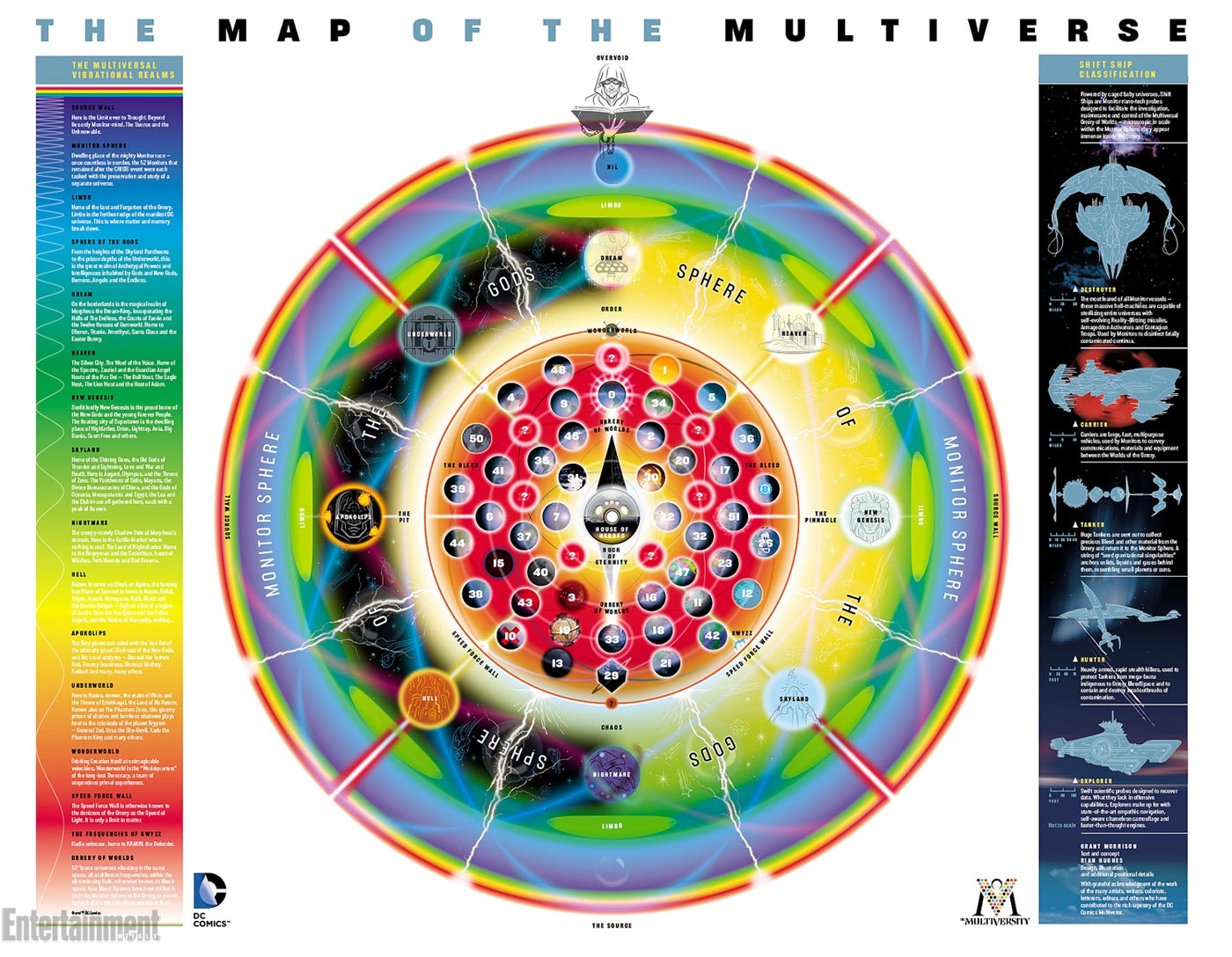 One thing missing from the Map of the DCU is the Anti-Matter Universe (where the Weaponers of Qward live). Does the Anti-Matter universe no longer exist? Would it be in the Orrery or not?
One thing missing from the Map of the DCU is the Anti-Matter Universe (where the Weaponers of Qward live). Does the Anti-Matter universe no longer exist? Would it be in the Orrery or not?Another interesting thing to note, as I mentioned earlier: the 'gods' live outside the Orrery. Zeus, Thor, Quetzalcoatl, Isis, etc. all live in Skyland. Meanwhile Hel, Hades and the like live in the Underworld. Apokolips and New Genesis both exist outside the Orrery, along with Heaven and Hell. This has interesting ramifications, as in: someone from Earth-0, Wonder Woman, is now the 'Greek God of War' for all the universes in the Orrery. Wow, really?
Ok, let's move into the guts of the Orrery of Worlds, the 52 Earths/Universes of the DCU. First I feel inclined to mention that back in the 1980s, when the CRISIS ON INFINITE EARTHS came out, one of its main goals (aside from making money) was to streamline the DCU, making it easier to understand--especially for newbies. Back then, there were no more than 38 known universes, most of which were one-offs for single storylines, like the CRISIS ON INFINITE EARTHS itself. Now DC has 52 worlds/universes, so any goal of streamlining has been thrown out the window--I weep for the newbies.
I feel the 52 Earths can be separated into five categories:
- Undefined Earths (you always gotta save room for the future): 7
- Reboot Earths (Earths from the Pre-Crisis days): 10
- Elseworlds Earths (and other previously out of continuity stories): 15
- New Home Earth (characters and stories now removed from the 'main' Earth): 5
- Grant Morrison Earths (recently created Earths by Grant Morrison): 15
 The REBOOT Earths: These are the typical DC Universes, like Earth-0 (the main Earth with the JLA), Earth-2 (the JSA Earth), and Earth-3 (the CSA Earth, which oddly enough is not mentioned as being destroyed). It also covers the newer reboots:
The REBOOT Earths: These are the typical DC Universes, like Earth-0 (the main Earth with the JLA), Earth-2 (the JSA Earth), and Earth-3 (the CSA Earth, which oddly enough is not mentioned as being destroyed). It also covers the newer reboots:Earth-4, home of the Charlton heroes, now seen through the prism of THE WATCHMEN (as seen in PAXAMERICANA #1). It also says Captain Atom is the only being with superpowers. But Nightshade, who is pictured, has superpowers, as do Son of Vulcan and Thunderbolt, assuming they still exist on Nu52 Earth 4.
Earth-5, which was originally written as Earth-S (get it?). This is the home of Captain Marvel and family (as seen in NEW THUNDERWORLD ADVENTURES #1). One would expect the rest of the old Fawcett characters live here as well (Bulletman, Spy Smasher, Mr. Scarlet, etc), though just like on Earth-0 & 2, all connections to the 1940s time period have been removed.
Earth-8 was originally just the planet Angor, with heroes based off Marvel's Avengers: Wandjina, Jack B. Quick, Blue Jay, and Silver Sorceress (as seen in THE MULTIVERSITY #1). Once called the Justifiers, now called the Retaliators, it’s loaded with new characters, which is typical for a writer to do when he writers these characters for the first time. Oddly enough, only Wandjina (now Wundajin) is mentioned. Also, how they always miss using the obvious General Glory and Atomic Knight is beyond me. Behemoth is a good addition, though.
 Earth-10, aka Earth-X (get it?) is home of the Freedom Fighters: Uncle Sam, Phantom Lady, Human Bomb, etc. (soon to be seen in MASTERMEN #1). Again, one would assume the rest of the old Quality characters live here as well (Red Bee, Invisible Hood, Neon the Unknown, etc). Just like Pre-Crisis, Nazi Germany won WWII and took over the world. This is where Nazi Superman and Nazi Supergirl from FINAL CRISIS came from. The Nazi Justice League is cute, although done before in YOUNG ALL-STARS as Axis Amerika featuring Ubermensch, Gudra, Horned Owlman and the like. I'm curious if the original foes of the Freedom Fighters are still around too: The Crusaders, which were a knock-off of Marvel's Invaders, featuring Americommando, Barracuda and Fireball.
Earth-10, aka Earth-X (get it?) is home of the Freedom Fighters: Uncle Sam, Phantom Lady, Human Bomb, etc. (soon to be seen in MASTERMEN #1). Again, one would assume the rest of the old Quality characters live here as well (Red Bee, Invisible Hood, Neon the Unknown, etc). Just like Pre-Crisis, Nazi Germany won WWII and took over the world. This is where Nazi Superman and Nazi Supergirl from FINAL CRISIS came from. The Nazi Justice League is cute, although done before in YOUNG ALL-STARS as Axis Amerika featuring Ubermensch, Gudra, Horned Owlman and the like. I'm curious if the original foes of the Freedom Fighters are still around too: The Crusaders, which were a knock-off of Marvel's Invaders, featuring Americommando, Barracuda and Fireball.Earth-26 is a reboot of Earth-C, where Captain Carrot and the Zoo Crew live. One would suspect other DC funny cartoon animals live here as well, like Fox and Crow, or Flippity and Flop, though I'm curious if Hoppy the Marvel Bunny lives here, or is he on Earth 5? While I'm at it, where do Sugar and Spice live? Or Scribbly, or Jonni DC?
Earth-33 is a reboot of Earth Prime, the Earth we all live on (soon to be seen in ULTRA COMIC #1, even though we see it every day). This is also the home of Superboy from CRISIS ON INFINITE EARTHS and the INFINITE CRISIS, who in theory shouldn't exist, but the consequences of his actions do (more later). It's also the home of Ultra, the once redheaded hero from the Pre-Crisis days who migrated to Earth 1 to prevent causing trouble on our world.
Earth 48 is a reboot of Earth 6 (not sure why it couldn't keep the same number), where America lost the Revolutionary War and the world is now ruled by a super-powered monarchy. Lord Volt is the man in charge with his wife Lady Quark (once the universe's sole survivor from COIE). Now this planet of super-powered beings is designed to fight Darkseid, presumably in Geoff Johns' upcoming war. Curious who designed these supe-powered 'beings'--maybe it was the mice again.
 The ELSEWORLD Earths: These are a collection of formerly out of continuity stories. Strangely, since many of them were period pieces past or future, DC decided to screw with their timelines. So while most of the 52 Universes are now in the 21st century, it's still the 18th century in others. Or, even weirder, it's the 21st century, but still looks like the 18th century.
The ELSEWORLD Earths: These are a collection of formerly out of continuity stories. Strangely, since many of them were period pieces past or future, DC decided to screw with their timelines. So while most of the 52 Universes are now in the 21st century, it's still the 18th century in others. Or, even weirder, it's the 21st century, but still looks like the 18th century.These universes are: EARTH-1 (not Pre-Crisis Earth-1, but DC's newest line of graphic novels--they now have their own defined universe), STAN LEE'S JUST IMAGINE heroes, the TANGENT line, BATMAN BEYOND (curious if the Justice League Unlimited team exist or existed here as well--Warhawk had to come from somewhere), the JUSTICE RIDERS (curious if other DC old west heroes live here as well, although the Old West has expanded to 2015?!?), GOTHAM BY GASLIGHT, NEW FRONTIER (somehow JFK was never assassinated here, so curious what this place looks like in 2015), KINGDOM COME, SUPERMAN: RED SUN, BATMAN: LEATHERWINGS, BATMAN: IN DARKEST NIGHT, BATGIRL AND ROBIN: THRILLKILLER (DC has tossed in a few of their old sci fi heroes in here as well, like Tommy Tomorrow and the Space Rangers), GENERATIONS (John Byrne's work of Superman and Batman from the 1940s growing old in real time), BATMAN: RED RAIN, and the Justice Lords from the JUSTICE LEAGUE cartoon series (I guess that makes sense--I mean, if BATMAN BEYOND gets a universe).
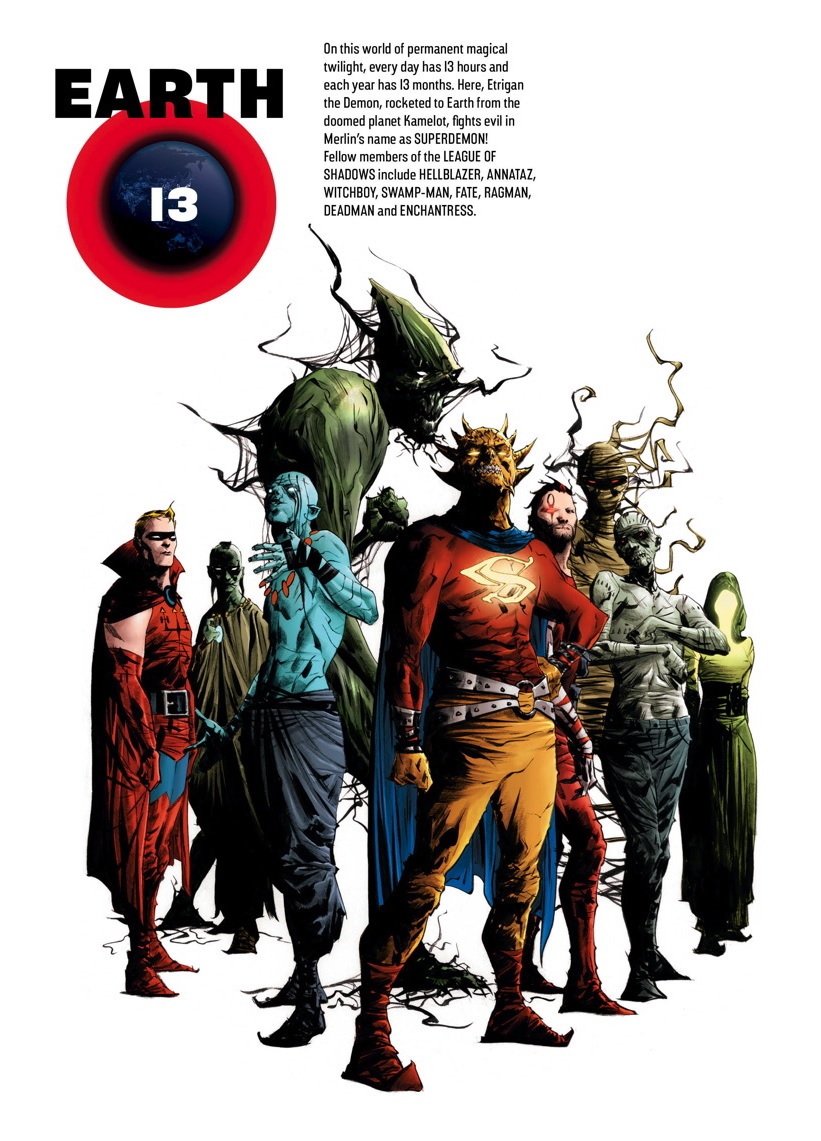 The NEW HOME Earths: Here we have characters that used to live on Earth-0 (or Pre-Crisis Earth-1), but now have a defined universe. This includes:
The NEW HOME Earths: Here we have characters that used to live on Earth-0 (or Pre-Crisis Earth-1), but now have a defined universe. This includes:Earth-13 - This is pretty much planet Vertigo, with many characters from DC's Vertigo line that play well with each other, but not with the greater DCU, plus other supernatural concepts.
Earth 15 - This universe is supposed to be the result of the INFINITE CRISIS, the universe that Alexander Luthor was trying to build before Superboy Prime destroyed it.
Earth 29 - This is Bizarro world, which kinda makes no sense at all. This means there is a whole Bizarro Universe: Bizarro Krypton, Bizarro Mars, Bizarro Oa, they must even have square Bizarro Suns- you know, ones that are cold instead of hot. Plus, Bizarro was always a creation of Lex Luthor- heck, even on Earth-16 Superboy (created by Lex) was turning into a Bizarro. So yeah, I don't get it.
Earth 47 - DC's hippie planet of old. Anything bizarre from DC, in an attempt to get hip with the counter culture, lives here. Talking about BROTHER POWER THE GEEK, PREZ, and mostly likely other characters like the original Green Team, Dingbats- heck, maybe even Lady Cop! A questionable timeline exist here as well--like, just how many terms is Prez serving?
Earth 51 - This is Jack Kirby world, mostly for his creation Kamandi, the last boy on Earth (seen right here in THE MULTIVERSITY GUIDEBOOK #1), but Morrison is tying this world very closely with the New Gods as well, so you can imagine any old Kirby creations for DC that don't fit in the other universes will wind up here. And again there is a question of timeline - is Kamandi running around in the 21st century?
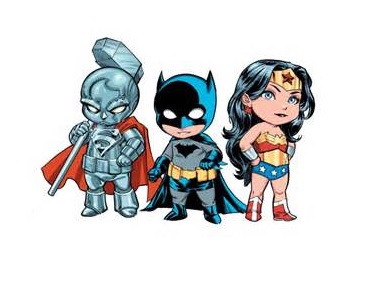 The GRANT MORRISON Earths: How great is it to be Grant Morrison? He can just $hi!t out Earths and DC publishes them. "I want an Earth where the Justice League all wears silly hats." "Done!"
The GRANT MORRISON Earths: How great is it to be Grant Morrison? He can just $hi!t out Earths and DC publishes them. "I want an Earth where the Justice League all wears silly hats." "Done!"Anyway, his universes are mostly different flavors of the Justice League, like The Justice Guild (gender swap world), The Just (as seen in THE JUST #1), Atomic Knights of Justice (a post-apocalypse world, combining the JLA with some old DC sci fi heroes like Adam Strange and the Atomic Knights), the Society of Super-Heroes (as seen in THE SOCIETY OF SUPER-HEROES #1), their evil opposite Earth with the Society of Super-Criminals, the race swap universe with President Calvin Ellis/Superman (although, shouldn't Vixen be white and Batman be black? Seriously, Batman is too cool to be white). Next we got the Light Brigade (Superman/Savior from the past), the Super-Americans (a universe created by the Monitors, which seems to go against everything the Monitors are doing), the Justice 9 (a planet victimized by Super Doomsday), a chibi world with a short and cute looking Justice League (maybe Sugar and Spice live here), and the Metal League (which combines the JLA with the Metal Men). Moving away from the Justice League knock-offs we get teams like Agents of W.O.N.D.E.R (a play on Tower Comics' T.H.U.N.D.E.R. Agents), Nimrod Squad (with Dino-Cop, a play on Erik Larsen's Savage Dragon, seen in THE MULTIVERSITY #1), the universe that created Super Doomsday (seen in ACTION COMICS). Morrison also created Earth-7, which is a knock-off of Earth-8 (the Marvel Comics knock-off). This universe was destroyed in THE MULTIVERSITY #1, except for Thunderer (Thor/Wandjina).
One thing that really sticks out to me as a long-time (and a bit grumpy) DC reader is the absence of the Earths we really wanted to see: Pre-Crisis Earth 1, Pre-Crisis Earth 2, Post-Crisis Earth, or even Post INFINITE or FINAL CRISIS Earth. I mean hell, the Justice Lords got an Earth - even the universe created by Alexander Luthor that was destroyed by Superboy-Prime in INFINITE CRISIS got an Earth number! The grumpy side of me suspects DC didn't make those Earths because too many fans would demand comics of them, and would negatively effect their current marketing plan.
Another thing missing: DC Online Earth. It's had its own comic book for years now. And with two Bruce Timm-inspired worlds, no Superfriends/Legion of Doom Earth? Or maybe even a Super Powers Earth?
In the end, either way you look at the DCU these days, mess or masterpiece, this is a nice issue and a nice encyclopedia of universes, with great art to boot. Easily worth the $8 price tag, assuming DC doesn't chuck it all with another reboot in April.

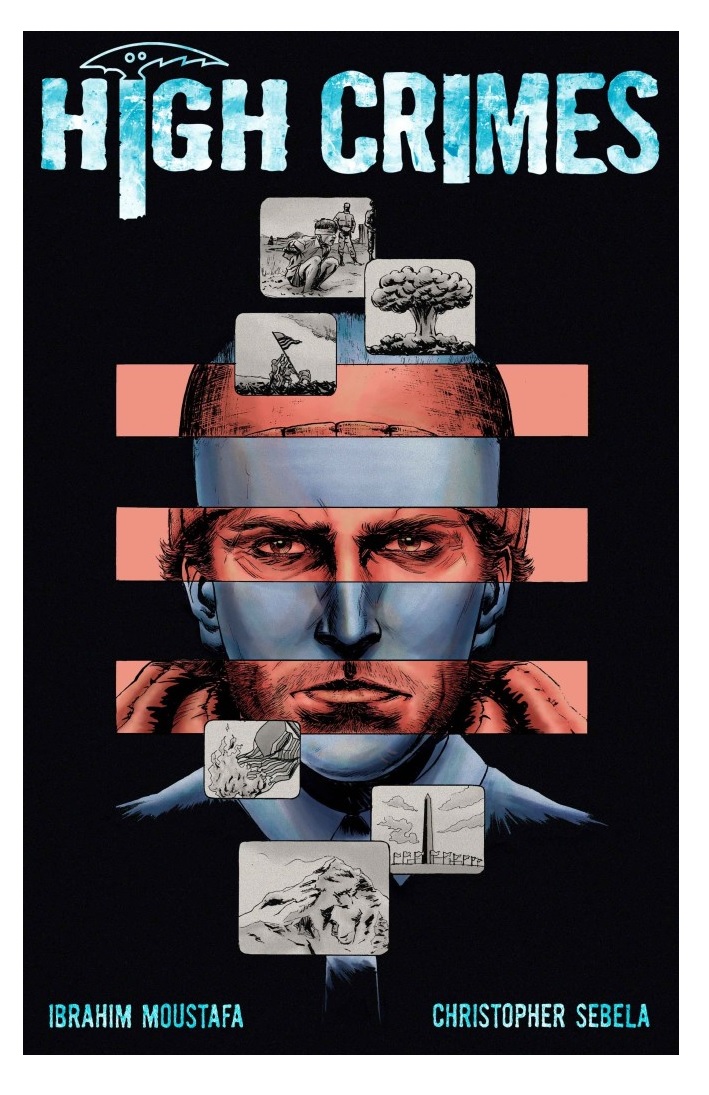
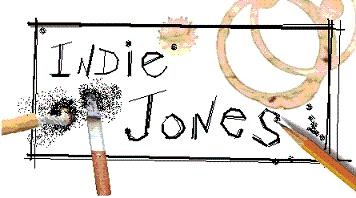
HIGH CRIMES #9
Writer: Christopher SebelaArtist: Ibrahim Moustafa
Publisher: Monkeybrain Comics
Reviewer: Morbidlyobesefleshdevouringcat
A good indicator that I will keep investing my time and money into a comic is usually when I have a physical reaction to it such as crying or pacing around the room. This time, I threw up. Right after finishing the latest issue of HIGH CRIMES by Christopher Sebela and Ibrahim Moustafa I ran straight to the bathroom to acquaint the toilet with the wonderful kale smoothie that my housemate had concocted for me earlier that morning. Bonding at its finest.
But I digress: I believe my overdramatic physical reaction may have been due to the ingestion of all of the currently released issues of HIGH CRIMES in one sitting. It’s not an easy series to get through. It’s a comic that is a study of extremes, not only in the physical violence that is taking place, but because it takes its readers into an affluent of nuances underlined by its very title. Aside from the obvious reference to the main plot following Zan Jensen and Haskell Price as Mount Everest's resident grave robbers, earning an income by bargaining with families who have had their loved ones die while attempting to climb the mountain, HIGH CRIMES references an abundance of allegories: Zan’s prolific past with fame and her downfall from that high into a world of addiction and illegal business. There’s also Sullivan Mars, the body that Price had found which now causes the pair to wish they were dead, an ex-member of The Strange Agents whose diary parallels Zan’s addictions and outlook on life--of course, with far more murder.
And that brings us to issue number nine, this time a flood with personal monologue from both Zan and Mars rather than the severe torture scenes that had been in the previous issues. Once again, Sebela’s writing combined with Moustafa’s art moves the issue forward, even though not much, physically, occurs in this issue. Left off from issue eight, Mars’ and Zan’s situation is paralleled through a diary-style monologue, this time allowing both Zan and Mars to see where they’ve ended up and how the loss of their childhood has also meant they’ve all along been digging their own graves.
I hope Zan finds hers soon. A part of me loves to hate HIGH CRIMES, mostly because Zan is such a horrible person. She’s selfish to the point of delusion, and as honest as her intentions may be, unfortunately that doesn't necessarily equate to what is right. You don't know whether to feel bad for her because of how irrational her far-too-young rise to fame has made her, or if you secretly want to applaud her for her bravery and perseverance. They do say that bravery and stupidity are interchangeable.
Although Zan’s a bit of a brat, she’s got some intelligence behind her, as her monologues also depict the cultural appropriation that her so-called job as a Mount Everest guide sees. The creative team’s back matter is filled with historical tidbits revolving around Everest as well as personal insights into the mountain, and one of those is how westerners view this mountain which the locals identify as a goddess. It’s disheartening, and simply adds to the overwhelming theme of personal gain.
Which is why I love this comic series so much. The writing isn’t clichéd; it holds true to honest emotions without being redundant or overly dramatic. Moustafa’s art is cinematically real. I also love that he’s a self-taught artist, making me want to root for him even more.
What’s even better about HIGH CRIMES is that it’s only 99 cents. Imagine what you could do with 99 cents. You could buy 19 five cent candies, or convince someone to give you a cigarette for a penny less than the usual asking price at the bar, or you could buy HIGH CRIMES from Monkey Brains and become completely enamored with a horrifying story and feel emotions that you weren’t expecting to feel at 7:53 AM on a Monday morning. Really, the choice is yours.
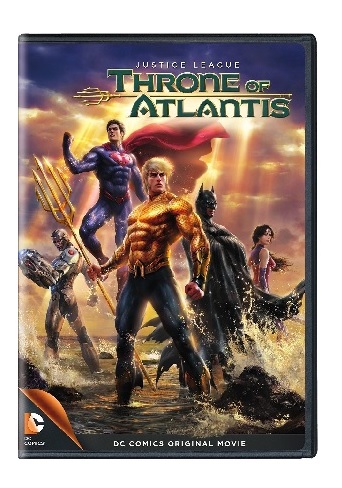 Comic Book Movie Review!
Comic Book Movie Review!JUSTICE LEAGUE: THRONE OF ATLANTIS (2015)
Director: Ethan SpauldingProduced: Warner Bros. Animation
Adapted from JUSTICE LEAGUE: THRONE OF ATLANTIS & AQUAMAN: THE TRENCH
Format: DVD & Blu-ray
Reviewer: Mighty Mouth
Overstuffed storytelling and missing essentials sink this fish story.
DC comics and Warner Animation have pumped out some incredible animated features over the years. Among my favorites are BATMAN: UNDER THE RED HOOD, SUPERMAN VS. THE ELITE, and JUSTICE LEAGUE: THE FLASHPOINT PARADOX. These films were successful for two reasons: simple, stunningly animated visuals combined with source material that’s kept mainly intact. It seems with the advent of features like JUSTICE LEAGUE: WAR and the abysmal BATMAN AND SON, a disturbing trend has been set in motion.
I’m not the biggest fan of the New 52. Nevertheless, good work deserves recognition. Both AQUAMAN: THE TRENCH and JUSTICE LEAGUE: THRONE OF ATLANTIS are impressive reads completely worthy of praise. With such brilliant source material to adapt, there is no way you could $#!% the bed, right?
Yeah, not so much.
The prime fallacy with THRONE OF ATLANTIS is all in the storytelling choices. Much of what these comics did so well is absent from this animated adaptation. Those witty moments that address the public’s misconception of Aquaman as little more than a guy who tête-à-têtes with fish have been utterly gutted from the narrative. As a substitute, the movies depict Aquaman as a brooding, drinking bar brawler struggling with identity issues; don’t even get started on the mishandling of the creatures known as The Trench.
Then there are the missing components from the JUSTICE LEAGUE comic of the same title. While the crux of the story remains more or less intact, some major plot points have been severely altered. I can’t help but question the reasoning for omitting more impactful parts of Atlantis’s invasion of the surface world, while more whimsical moments like Clark and Diana’s night out remain fully whole. It’s these types of options that render what should have been the film’s climax scrupulously impotent. I mean, Ocean Master being capable of taking on the entire Justice League--it’s almost laughable.
That’s not to say this feature is devoid of any entertainment value. The animation is once again vivacious, and there’s plenty of gratuitous yet stylish violence. The exchanges between Green Lantern (Nathan Fillion) and Batman (Jason O'Mara) are amusing. Oh, and the one gem I truly treasured happens during Aquaman and Black Manta’s confrontation; let’s just say Manta’s gonna need a bigger boat.
THRONE OF ATLANTIS struggles to integrate two of the very successful stories, but ultimately spites itself by ignoring the essentials that made these stories so engaging in the first place. It wasn’t horrible. It wasn’t great. It’s just kind of…meh.
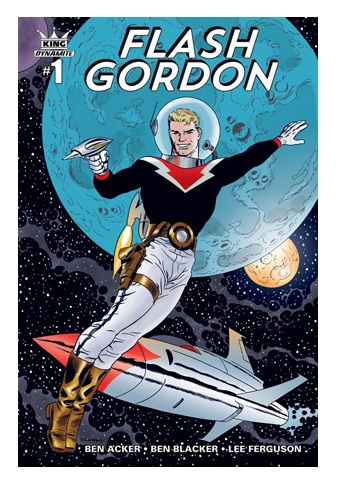
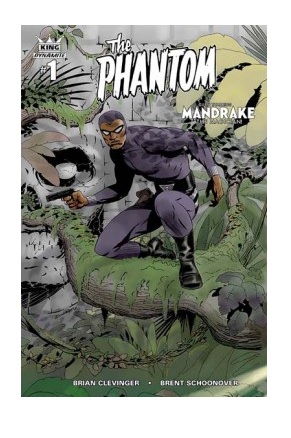
KING: THE PHANTOM #1/KING: FLASH GORDON #1
Writers: Brian Clevinger/Ben AckerArtists: Brent Schoonover/Ben Blacker
Publisher: Dynamite Entertainment
Reviewer: Masked Man
I'm breaking all the rules here and reviewing two comics at the same time. Why? Because it's the launch of Dynamite's new King line, which features classic King Features newspaper comic strip heroes, starting with The Phantom and Flash Gordon. Just like Dynamite's success with building a pulp hero world, now they are trying create a successful comic strip-based world building off of Jeff Parker's KINGS WATCH (basically a re-imagining of the 80s cartoon DEFENDERS OF THE EARTH) and his more successful sequel, FLASH GORDON.
So all of the King comics are based in a world that just survived an attack by Mongo, taking place in present day and destroying our technological infrastructure, making things more like 1915 than 2015. Also as a result of KINGS WATCH, The Phantom is dead (long live The Phantom!). Actually, no one knows where the next Phantom is (son of the last Phantom) so Mandrake the Magician's (who has his own comic coming soon) buddy Lothar has taken up the mantle of The Phantom until Christopher Walker can be found. Gotta say, this is pretty cool that an African man is finally getting a chance to be an African hero! Typically, it's all white women and white guys. Mind you, a dark-skinned Phantom does kinda mess with the immortal Phantom bit, as most people will be able to tell it's not the same guy. But as a Phantom fan, I'm down with it.
Along with the awesome cover by Darwyn Cooke, this is a pretty good first issue. Clevinger gets us right into the action of a (to be honest fairly typical) Phantom story of mercenaries running around Africa. But all the characters are likable and the action is good, as is the pacing. Meanwhile, Schoonover is a good artist and does a fine job telling this story. His style is actually in the Darwyn Cooke vein, but he has a few more years of honing to do before he reaches Cooke's level. After a rather sloppy Phantom series a few years back, Dynamite might finally have a hit here with The Phantom.
Over on the cosmic side, Jeff Parker and Evan Shaner's stellar run on FLASH GORDON comes to an end and Ben Acker and Ben Blacker pitch up the ball to run with it. As with the Phantom set-up, the world is rebuilding after the attack by Ming (the Merciless) on Mongo. But with his usual compadres Dale Arden and Hans Zarkov, Flash doesn't wait and takes the fight to Mongo. Unlike the old days, Ming's empire is now a collection of planets instead of countries. Sky City is now Sky World and Arboria is now a jungle planet. Like Parker, Acker keeps the story light, fast, and fun. Unfortunately, there seems to be a big disconnect between him and Blacker, as I could barely understand anything going on in this issue.
The actions taking place are never fully explained, as Flash and company are working in a slave mine before they get captured. And I'm sorry, but Blacker's artwork is just lazy. He seems to do everything he can to prevent drawing a fully fleshed out scene that describes the location, movement within the scene, or any articulation with character interaction. For instance, as it's described in the issue, “This Vessel...” seriously, that's all they say about it (aside from Zarkov correcting Flash by saying it's not a rocket) is never fully drawn by Blacker (I guess he didn't know what it was either). Of the five panels 'the vessel' is in, it's either covered in speedlines or only a small part of it is shown. That small part usually fills up the panel as well, so you can't really see it or any context of where the hell it is! This is a massive step backwards from Parker and Shaner's work. I sure hope it improves fast; it would be a real shame to waste their efforts with a quickly canceled book.
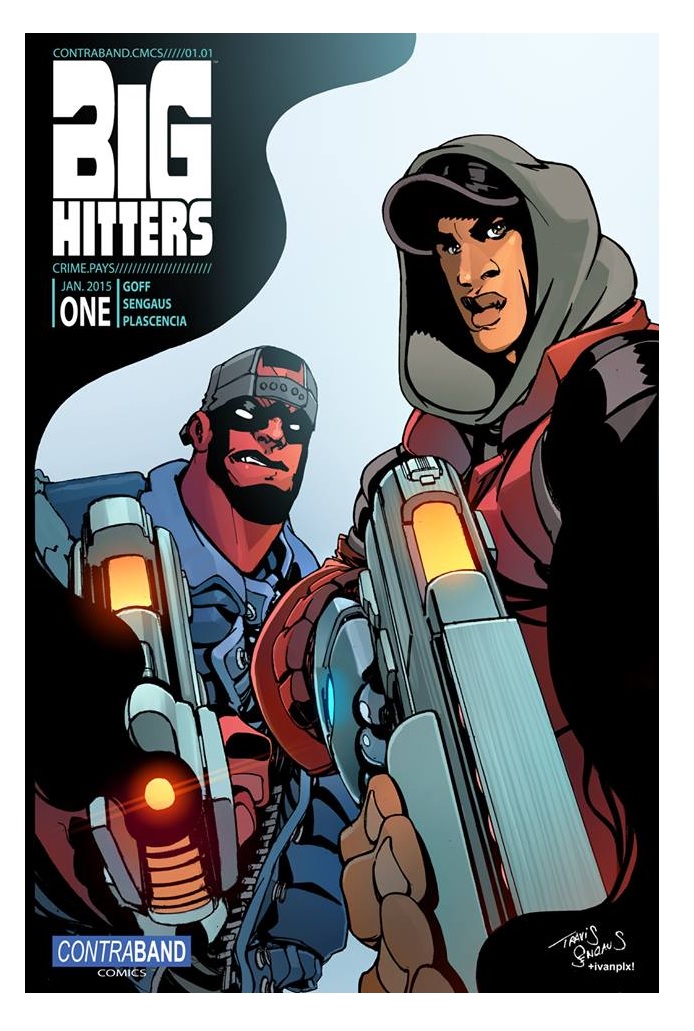

BIG HITTERS #1
Writer: Jon GoffArtist: Travis Sengaus
Publisher: Contraband Comics
Reviewer: The Kid Marvel
I’m going to try and keep this review as spoiler free as possible, sticking to the broadest details, in order to preserve BIG HITTERS plot.
BIG HITTERS is an indie comic starring two intergalactic bounty hunters looking to score big with their latest job. The story begins with them capturing their latest target, a super scientist, and delivering him to their employer. After a couple pages, BIG HITTERS’ time skips backwards in order to give some background on the two main characters and their current job. After getting to know Fresh and Mack, the main characters, the story shifts back to present before closing out on a cliff hanger.
Overall, I thought BIG HITTERS was a pretty solid comic. In the first issue, Goff does a solid job of painting the story’s world and establishing the personality distinctions of Fresh and Mack. A larger portion of BIG HITTERS is dedicated to dialogue between the two, fleshing out a little bit of their history and their current situation, as well as who they are as characters. I also really liked the concept for the book; I mean, who doesn’t like space bounty hunters? Besides character building, Goff does a really good job making the first issue seamless in where it’s going. It lays the needed foundation for the story, with the ending really creating interest for future stories. BIG HITTERS knows what it is, seems to know where it wants to go and has a solid base to build from.
The artwork is also exceptional and something I really liked. There’s a nice comedic feel to how the art is structured, keeping things lighthearted and mixing perfectly with the story’s tone. The colors are vibrant and strong, perfect for a book about space and future technologies. I really liked the designs Sengaus came up with for the characters, along with the styles and shadowing. The art fits beautifully with the script itself, with everything coming together for a great finished product.
If you’re into indies, action comics or stories regarding space adventures, I would definitely check this one out. BIG HITTERS has a good mix of action and dialogue as well as fun, lighthearted tone. While I know this review is a little shorter my usual ones, that’s because school started and I’m already late in turning this in--it isn’t a reflection of the book. I loved the story and I look forward to the future issues.
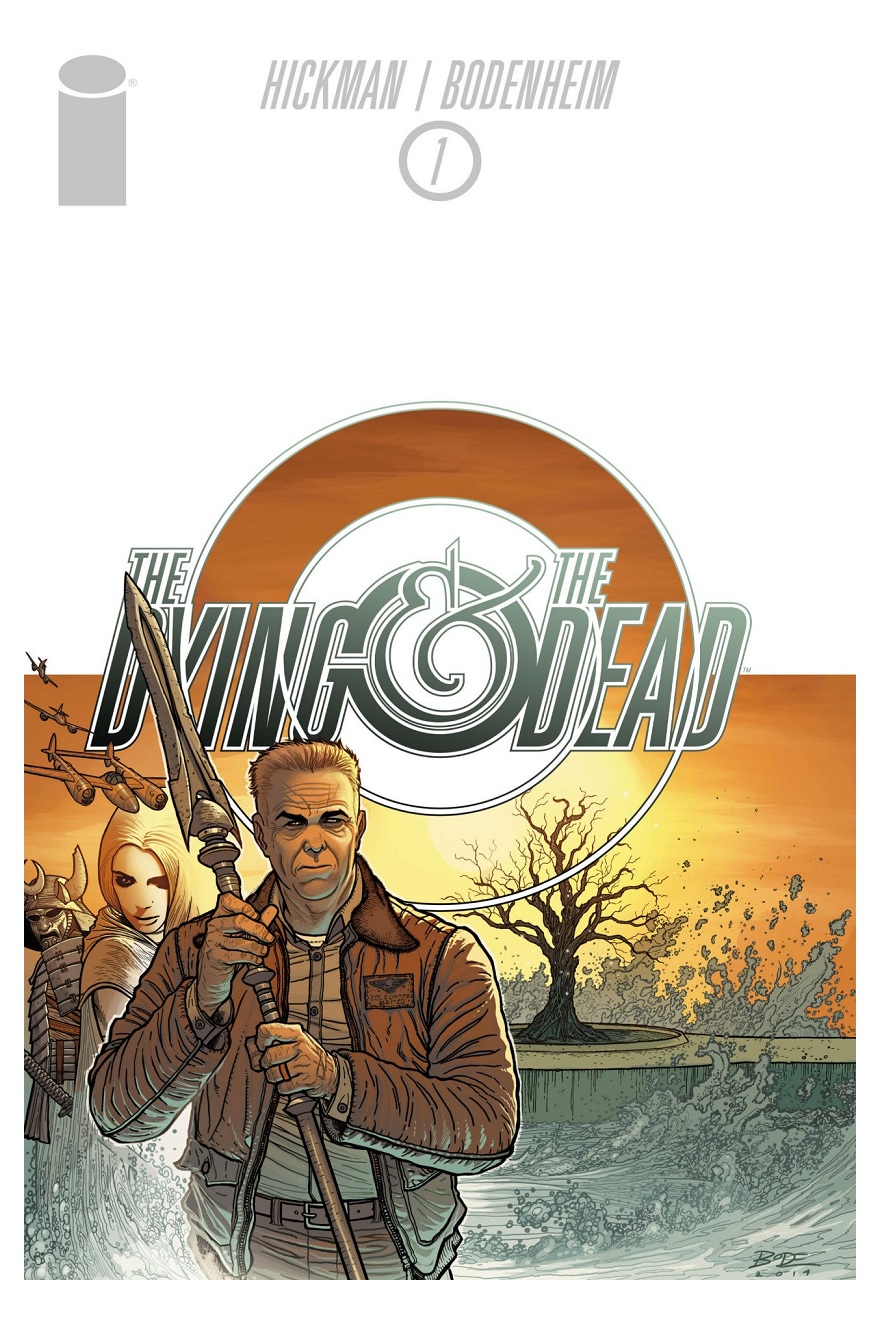
THE DYING AND THE DEAD #1
Writer: Jonathan HickmanArtist: Ryan Bodenheim
Publisher: Image Comics
Reviewer: Humphrey Lee
It feels weird saying this about a writer who has proven time and again to think outside the box in the medium, even on high profile superhero comics where box thinking tends to be constrained tightly by editors, but by now I think we kind of have an idea of what a Jonathan Hickman comic book is going to feel like. Now, that is not a slight--it’s just a pretty apparent observation that the man has a tone he mostly writes toward and definitely has a visual style he likes to get out of the artists he works with to bring these themes to life. With a Hickman book you know you’re going to get an epic feeling saga and your lead is going to be a hard man with heavy personal problems on his shoulders that may also tie into the fate of the world. And that’s all fine and dandy and I in no way mean it as a slight, because what brings you back again and again to what a guy like Hickman puts out there is the world he creates for these conflicts to take place in or the scope of these fights. Take EAST OF WEST, for example, where at its heart it’s just a revenge tale, except that its central character is Death of the fucking Four Horsemen and it takes place in some weird, mystic alternate reality Earth stemming from a Civil War that lasted decades and went horribly pear-shaped. So, basically, when it comes to new Hickman books like THE DYING AND THE DEAD here, you hop in to see what the stakes are or who the enemy is and try and glean an inkling of the breadth of the tale we’re going to get for however many years to come.
That is very much the opening of THE DYING AND THE DEAD with long-time collaborator Ryan Bodenheim. This issue is so packed with premise, cementing that it is actually goddamn triple-sized for your enjoyment--the problem being, there’s a lot of “padding” going on here, and while a lot of words are being said and the visuals are goddamn gorgeous I’m still not quite sure, which is what outside of the immediate dilemma put in front of our lead character. Now, PLEASE, don’t take any of the implied negativity in that last sentence to heart in a “HOLY SHIT THE HICKMAN HAS LOST HIS TOUCH AND WE ARE THE DOOMED!” manner; let me kind of break down the book and explain my thought process here.
THE DYING AND THE DEAD opens with just those two things, just in the reverse order of that title card. We start with an introduction letting us know it’s the late 1960s and we’re at a wedding that ends in a bloodbath of Red Wedding proportions (i.e. a fuckton of people die, for those not on the “Game of Thrones” beat) but this one is an inside job. Our brand new bride is really a part of the submachine gun-adorned group that comes calling, and it is all for the sake of grabbing a nondescript lock box out of a vault full of historical pieces. We then cut to a hospital bedside ,where Colonel Edward Canning is watching his longtime bride succumb to cancer and is then told by a rather shady-looking gentleman that a man known as “The Bishop” has a proposal for him and could potentially save his wife. And then the rest of the book is interspersed with a mix of seeing what the assassins do with said lockbox – introducing a fuckton of clones and chanting on about someone/thing named Bah al’Sharur – and the Colonel going to see this “Bishop” about his proposal while in that hallows of a mysterious and gorgeous underground realm.
Now, if all of that sounds interesting, well good because that is indeed the case. And if it doesn’t, that’s probably my bad for not describing it well enough because it indeed is cool as shit. You have (probably) Nazi remnants and most likely science experiments doing some wetwork to get a mysterious item and a hardened former man of action willing to get deep in it again with some secret, ancient group to save his dying love. All of that is great and cool and not the problem that I kind of had with this issue. When you break that all down to the Cliff Notes of “guy dies, box is taken, wife has cancer, guy accepts ominous mission to save her” does that really sound like three issues’ worth of content? And I’m not making a “this is decompressed as part of a money grab and rabble rabble rabble!” type of argument like permeated forums and whatnot a decade ago when the Marvel widescreen style became a thing. It’s just that, well, despite how solid and intriguing the premise is and how breathtaking the visuals were (seriously, such a goddamn gorgeous book) there just seemed like a lot of not “slow burn”, but kind of “repetitive burn”, with dialogue chains that seem to be repeating themselves and some extra panels for that cinematic effect that might have been superfluous (except for being gorgeous, which I guess was the point).
So there you have it, I guess? My analysis of this debut is that it is really, really good and pretty and we probably got more of it than we needed and it reads just like you kind of expect a Hickman book to read by now, if that makes any sense at all. I guess to spin this into a criticism a sane person would make, if you are not a fan of what the man produces script-wise, then THE DYING AND THE DEAD is not going to appeal to you. And, still guesstimating, I figure I just found a little disconcerting the pacing of this giant-sized issue as far as what actually occurred in the span of it. If this one issue were actually three individual issues at a regular price, I’d probably feel a little shafted. As it is presented right now, it’s a goddamn deal and a half and full of enjoyable takes on some pretty standard comic book tropes smashed together in a way only guys like Hickman and Bodenheim could muster. Overall, though - as with the majority of Jonathan Hickman joints, to be fair - it may just be another case to make for tradewaiting for material of his to reduce the quick impact of the cinematic approach that material has. Regardless, THE DYING AND THE DEAD, no matter how it parses itself out, looks to be as driven and stylistic and action-packed (and did I mention fucking stunning to look at yet?) as anything the man has produced to date.
Humphrey Lee has been an avid comic book reader going on fifteen years now and a contributor to Ain't It Cool comics for quite a few as well. In fact, reading comics is about all he does in his free time and where all the money from his day job wages goes to - funding his comic book habit so he can talk about them to you, our loyal readers (lucky you). He's a bit of a social networking whore, so you can find him all over the Interwebs on sites like Twitter, Facebookand a blog where he also mostly talks about comics with his free time because he hasn't the slightest semblance of a life. Sad but true, and he gladly encourages you to add, read, and comment as you will.
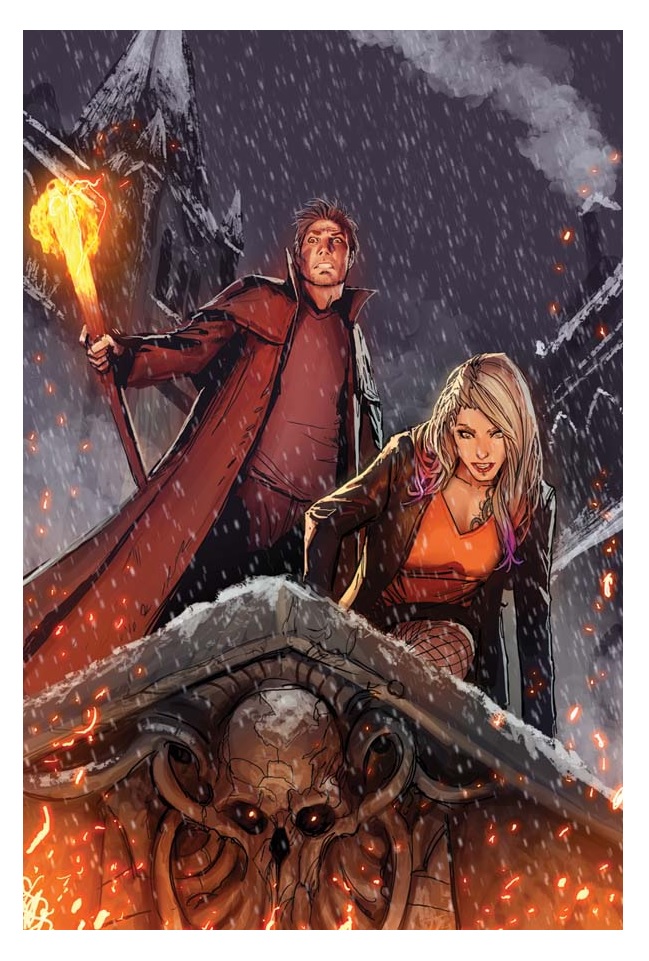
 In stores today!
In stores today!THE DRESDEN FILES: DOWN TOWN #1
Writer: Jim Butcher and Mark PowersArtist: Carlos Gomez
Publisher: Dynamite Entertainment
Reviewer: Lyzard
Forget the Syfy channel show. Put aside the Jim Butcher books. Unlike some of the other DRESDEN FILE comic publications, DOWN TOWN is an original story. For non-readers this makes it much more accessible than previous runs, and for fans of the series they can get a refreshing look at the characters they love without retreading old material. The events in DOWN TOWN take place in the timeline surrounding SMALL FAVOR, the tenth book in the urban fantasy series. Though this story has the potential to spoil a good two thirds of the series for any newcomers, the comic has thus far steered away from many of the twists and turns that appear in the previous nine books.
In DOWN TOWN, Harry Dresden and his apprentice, Molly Carpenter, are called to help out Karrin Murphy and the Chicago PD solve a grisly murder. And when I say grisly, I mean Clive Barker meets Wes Craven. Dresden will have to go deep into his bag of tricks to crack this one and do so without pissing off any more vampires, demons, or worst of all, human power-hungry mobsters.
What I can only imagine as a byproduct of having the author co-writing is the comic’s ability to provide enough “previously on” tidbits as to catch up readers without interfering with the events at hand. What would be a refresher course for some is necessary, worthwhile, and interesting background info delivered in an unobtrusive and somewhat entertaining manner.
As a fan of Butcher’s work there are a few elements that irked me with this comic. Dresden is a bit too ruggedly handsome and my favorite character, Bob, is absent. But those are gripes that will only be shared by a few in the fan base and while the look may not be right for our gruff wizard, the attitude and sass are. Surprisingly, the rest of the comic is rather accurate in the visual portrayals of characters, a refreshing change from the alterations that appeared on the television show.
THE DRESDEN FILES: DOWN TOWN is a hard pitch for those who haven’t been following the adventures of Harry Dresden. It is difficult to encapsulate what makes the book series so different from the rest of the urban fantasy out there on the market. While I cannot expound upon why those unfamiliar with the series would want to check this book out, I can at least say it is easier to dive in to than with most adaptation material. And for those, like me, who need something to read before PEACE TALKS finally comes out, DOWN TOWN is a worthy filler.
Proofs, co-edits & common sense provided by Sleazy G
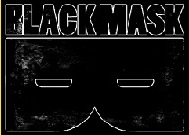 The next level of comic book excellence is a click away at BLACK MASK STUDIOS!
The next level of comic book excellence is a click away at BLACK MASK STUDIOS! Want more in all things Geek?
Want more in all things Geek?Check out our friends at PoptardsGo for podcasts, reviews, and more!
 And if you still need more geek in your life, check out Part-Time Fanboy for more geeky goodness on comics, movies, and more!
And if you still need more geek in your life, check out Part-Time Fanboy for more geeky goodness on comics, movies, and more!Finally, check out AICN COMICS on Facebook and Comixpedia!
